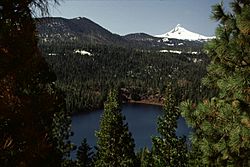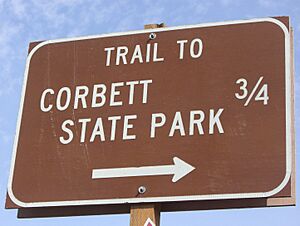Elliott Corbett Memorial State Recreation Site facts for kids
Quick facts for kids Corbett State Park |
|
|---|---|

Park area before the B&B Fire
|
|
| Lua error in Module:Location_map at line 420: attempt to index field 'wikibase' (a nil value). | |
| Location | Jefferson County, Oregon |
| Nearest city | Sisters, Oregon |
| Area | 63 acres (25 ha) |
| Created | 1952 |
| Operated by | Oregon Parks and Recreation Department |
| Open | Year-around |
Elliott Corbett Memorial State Recreation Site is a special place in Jefferson County, Oregon. It's also known as Corbett State Park. This park is found along the south shore of Blue Lake Crater.
The park is named after Elliott R. Corbett II. He was a brave soldier who died while serving in the United States Army during World War II. The park covers about 63 acres (25 hectares) of wild land. It has very few buildings or facilities, keeping it natural. The Oregon Parks and Recreation Department takes care of Corbett State Park.
Contents
Where is Corbett State Park?
Corbett State Park is a 63-acre area of forest and open meadow. It sits above the south shore of Blue Lake. This park is located east of the Cascade Range in Central Oregon. You can find it just south of Highway 20. It's about 4 miles (6.4 km) east of Santiam Pass. The town of Sisters is about 14 miles (22.5 km) to the west.
The park's elevation changes from 3,468 feet (1,057 meters) at Blue Lake. It goes up to over 3,600 feet (1,097 meters) on the hills above the lake.
About Blue Lake
Blue Lake is a very deep lake. It fills a large volcanic hole called a caldera. The lake is 314 feet (96 meters) deep, making it one of Oregon's deepest lakes. The sides of the caldera are very steep. This makes the lake shore in Corbett State Park quite rugged.
The only water flowing out of Blue Lake is Link Creek. This shallow stream starts at the north end of the lake. Link Creek then flows into Suttle Lake, which is about 0.6 miles (1 km) away.
Park History
Long ago, in the 1800s, the main meadow in what is now Corbett State Park was a popular stop. It was on a pioneer wagon road that crossed the Cascade Mountains. Pioneer travelers liked this spot because it had fresh water. It also offered good grass for their draft animals, like horses or oxen. In the early 1900s, sheepherders also used the meadow. They grazed their sheep flocks in the eastern foothills of the Cascades.
The Oregon Parks and Recreation Department got the land for the park in 1952. It was a gift from Henry L. Corbett and his wife, Gretchen. They gave the land to honor their son, Elliott R. Corbett II. Elliott was an infantry soldier in the United States Army. He was killed in action during World War II on November 19, 1944. He was only 22 years old. Elliott is buried in the Netherlands American Cemetery in the Netherlands. The Corbett family wanted the land to stay a wild area.
In August 2003, a large wildfire called the B&B Complex Fires burned the area. Most of Corbett State Park was affected. But within a year, the forest started to grow back. Today, the park and the surrounding forest are still recovering from the fire.
Wild Nature
Corbett State Park is a 63-acre wild area meant for day visits. You can't stay overnight. The park's main feature is a big open meadow. This meadow is surrounded by ponderosa and lodgepole pine trees. The park also has areas along two seasonal streams. These areas are called riparian habitats.
Even though the park is fairly small, many different animals live there. The forest on the hills above Blue Lake is home to several mammals. These include mule deer, black-tailed deer, black bears, badgers, bobcats, and cougars. Smaller mammals you might see are chipmunks, ground squirrels, shrews, and voles.
Many birds can be found in or near the park, such as:
- Mountain chickadees
- Red-breasted nuthatches
- Brown creepers
- Dark-eyed juncos
- Western tanagers
- Chipping sparrows
- Red crossbills
- Golden-crowned kinglets
- Ruby-crowned kinglets
- Steller's jays
Other birds in the forest include northern flickers, western wood-pewees, olive-sided flycatchers, and pine siskins. Since the 1990s, Pileated woodpeckers and hairy woodpeckers have been common. This is because a bug problem (spruce budworm) increased their food supply. Blue Lake and nearby Suttle Lake attract birds of prey. These include red-tailed hawks, osprey, and bald eagles. You might also see vultures. Osprey and eagles often stay late into the fall. They feed on brown trout and kokanee salmon that lay eggs in Link Creek.
Fun Activities
Corbett State Park offers different ways to enjoy the wilderness. The most popular activities are hiking, mountain biking, and horseback riding. Visitors can also fish in Blue Lake. However, it can be hard to reach the lake because the caldera sides are very steep. Kokanee salmon are also found in the lake.
You can only get to Corbett State Park by hiking. There are no roads that go directly into the park. From the west, the Corbett Park trail starts at a small parking area. This is along Forest Service Road 2076, about 0.75 miles (1.2 km) south of Highway 20. From there, you hike 2 miles (3.2 km) east through the Deschutes National Forest to reach the park's main meadow.
From the east, the park trail begins at Camp Caldera. From this camp, you can hike along the Blue Lake Crater Rim Trail. This trail goes around the lake. However, the trail on the east side of the lake is on private land. The entire loop trail around the lake is about 2.5 miles (4 km) long. You can also hike a waterfall loop trail on the south side of the park. This trail leaves the meadow and goes to the falls. Then it curves back north towards the meadow and the Dark Lake trail.
In the winter, Corbett State Park is a great place for cross-country skiing and snowshoeing. Motorized vehicles, like snowmobiles, are not allowed in the park at any time of year.
Because you have to hike to get there, Corbett State Park doesn't have many visitors. There is no fee to use the park. However, the park has very few facilities. There is no drinking water or toilets for visitors. Signs within the park are also limited. This is done on purpose to help people feel like they are truly in a wild place.
Images for kids




